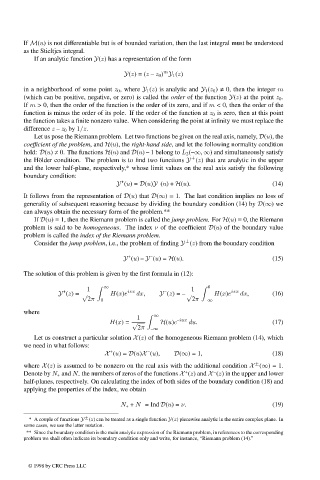Page 518 - Handbook Of Integral Equations
P. 518
If M(u) is not differentiable but is of bounded variation, then the last integral must be understood
as the Stieltjes integral.
If an analytic function Y(z) has a representation of the form
m
Y(z)=(z – z 0 ) Y 1 (z)
in a neighborhood of some point z 0 , where Y 1 (z) is analytic and Y 1 (z 0 ) ≠ 0, then the integer m
(which can be positive, negative, or zero) is called the order of the function Y(z) at the point z 0 .
If m > 0, then the order of the function is the order of its zero, and if m < 0, then the order of the
function is minus the order of its pole. If the order of the function at z 0 is zero, then at this point
the function takes a finite nonzero value. When considering the point at infinity we must replace the
difference z – z 0 by 1/z.
Let us pose the Riemann problem. Let two functions be given on the real axis, namely, D(u), the
coefficient of the problem, and H(u), the right-hand side, and let the following normality condition
hold: D(u) ≠ 0. The functions H(u) and D(u) – 1 belong to L 2 (–∞, ∞) and simultaneously satisfy
±
the H¨ older condition. The problem is to find two functions Y (z) that are analytic in the upper
and the lower half-plane, respectively,* whose limit values on the real axis satisfy the following
boundary condition:
+
–
Y (u)= D(u)Y (u)+ H(u). (14)
It follows from the representation of D(u) that D(∞) = 1. The last condition implies no loss of
generality of subsequent reasoning because by dividing the boundary condition (14) by D(∞)we
can always obtain the necessary form of the problem.**
If D(u) ≡ 1, then the Riemann problem is called the jump problem.For H(u) ≡ 0, the Riemann
problem is said to be homogeneous. The index ν of the coefficient D(u) of the boundary value
problem is called the index of the Riemann problem.
Consider the jump problem, i.e., the problem of finding Y (z) from the boundary condition
±
+
–
Y (u) – Y (u)= H(u). (15)
The solution of this problem is given by the first formula in (12):
∞ 0
1 1
+ izx – izx
Y (z)= √ H(x)e dx, Y (z)= – √ H(x)e dx, (16)
2π 0 2π –∞
where
1 ∞ –iux
H(x)= √ H(u)e du. (17)
2π –∞
Let us construct a particular solution X(z) of the homogeneous Riemann problem (14), which
we need in what follows:
–
+
X (u)= D(u)X (u), D(∞) = 1, (18)
where X(z) is assumed to be nonzero on the real axis with the additional condition X (∞)=1.
±
+
–
Denote by N + and N – the numbers of zeros of the functions X (z) and X (z) in the upper and lower
half-planes, respectively. On calculating the index of both sides of the boundary condition (18) and
applying the properties of the index, we obtain
N + + N – = Ind D(u)= ν. (19)
±
* A couple of functions Y (z) can be treated as a single function Y(z) piecewise analytic in the entire complex plane. In
some cases, we use the latter notation.
** Since the boundary condition is the main analytic expression of the Riemann problem, in references to the corresponding
problem we shall often indicate its boundary condition only and write, for instance, “Riemann problem (14).”
© 1998 by CRC Press LLC
© 1998 by CRC Press LLC
Page 500

